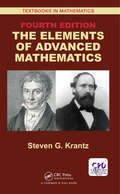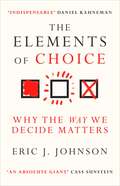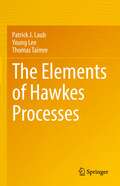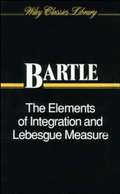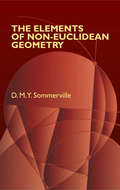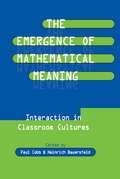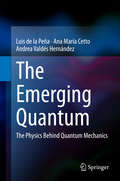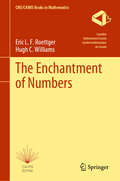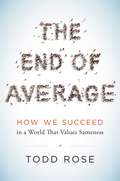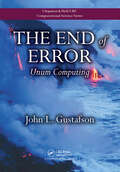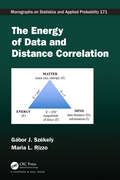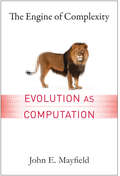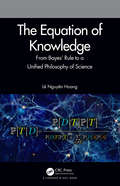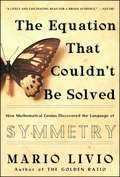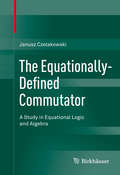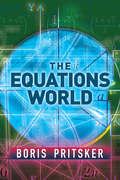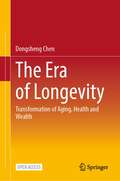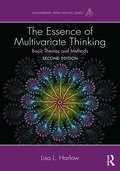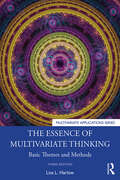- Table View
- List View
The Elements of Advanced Mathematics (Textbooks in Mathematics)
by Steven G. Krantz<p>The Elements of Advanced Mathematics, Fourth Edition is the latest edition of the author’s bestselling series of texts. Expanding on previous editions, the new Edition continues to provide students with a better understanding of proofs, a core concept for higher level mathematics. To meet the needs of instructors, the text is aligned directly with course requirements. <p>The author connects computationally and theoretically based mathematics, helping students develop a foundation for higher level mathematics. To make the book more pertinent, the author removed obscure topics and included a chapter on elementary number theory. Students gain the momentum to further explore mathematics in the real world through an introduction to cryptography. These additions, along with new exercises and proof techniques, will provide readers with a strong and relevant command of mathematics.</p>
The Elements of Advanced Mathematics (Textbooks in Mathematics)
by Steven G. KrantzThis book has enjoyed considerable use and appreciation during its first four editions. With hundreds of students having learned out of early editions, the author continues to find ways to modernize and maintain a unique presentation. What sets the book apart is the excellent writing style, exposition, and unique and thorough sets of exercises. This edition offers a more instructive preface to assist instructors on developing the course they prefer. The prerequisites are more explicit and provide a roadmap for the course. Sample syllabi are included. As would be expected in a fifth edition, the overall content and structure of the book are sound. This new edition offers a more organized treatment of axiomatics. Throughout the book, there is a more careful and detailed treatment of the axioms of set theory. The rules of inference are more carefully elucidated. Additional new features include: An emphasis on the art of proof. Enhanced number theory chapter presents some easily accessible but still-unsolved problems. These include the Goldbach conjecture, the twin prime conjecture, and so forth. The discussion of equivalence relations is revised to present reflexivity, symmetry, and transitivity before we define equivalence relations. The discussion of the RSA cryptosystem in Chapter 8 is expanded. The author introduces groups much earlier. Coverage of group theory, formerly in Chapter 11, has been moved up; this is an incisive example of an axiomatic theory. Recognizing new ideas, the author has enhanced the overall presentation to create a fifth edition of this classic and widely-used textbook.
The Elements of Cantor Sets--with Applications
by Robert W. VallinA systematic and integrated approach to Cantor Sets and their applications to various branches of mathematics The Elements of Cantor Sets: With Applications features a thorough introduction to Cantor Sets and applies these sets as a bridge between real analysis, probability, topology, and algebra. The author fills a gap in the current literature by providing an introductory and integrated perspective, thereby preparing readers for further study and building a deeper understanding of analysis, topology, set theory, number theory, and algebra. The Elements of Cantor Sets provides coverage of: Basic definitions and background theorems as well as comprehensive mathematical details A biography of Georg Ferdinand Ludwig Philipp Cantor, one of the most significant mathematicians of the last century Chapter coverage of fractals and self-similar sets, sums of Cantor Sets, the role of Cantor Sets in creating pathological functions, p-adic numbers, and several generalizations of Cantor Sets A wide spectrum of topics from measure theory to the Monty Hall Problem An ideal text for courses in real analysis, topology, algebra, and set theory for undergraduate and graduate-level courses within mathematics, computer science, engineering, and physics departments, The Elements of Cantor Sets is also appropriate as a useful reference for researchers and secondary mathematics education majors.
The Elements of Choice: Why the Way We Decide Matters
by Eric J. Johnson&‘Indispensable&’ Daniel Kahneman How do you get people to donate their organs? What&’s the trick to reading a wine list? What&’s the perfect number of potential matches a dating site should offer? Every time we make a choice, our minds go through an elaborate process most of us never even notice. We&’re influenced by subtle aspects of the way the choice is presented that often make the difference between a good decision and a bad one. To overcome the common faults in our decision-making and enable better choices in any situation involves conscious and intentional decision design. Transcending the familiar concepts of nudges and defaults, The Elements of Choice offers a comprehensive, systematic guide to creating effective choice architectures, the environments in which we make decisions. The designers of decisions need to consider all the elements involved in presenting a choice: how many options to offer, how to present those options, how to account for our natural cognitive shortcuts, and much more. These levers are unappreciated, yet they impact our reasoning every day. This book doesn&’t simply analyse the mental fallacies that trip us up. It goes further to show us what good decision-making looks like – that it can be both moral and effective.
The Elements of Hawkes Processes
by Thomas Taimre Patrick J. Laub Young LeeHawkes processes are studied and used in a wide range of disciplines: mathematics, social sciences, and earthquake modelling, to name a few. This book presents a selective coverage of the core and recent topics in the broad field of Hawkes processes. It consists of three parts. Parts I and II summarise and provide an overview of core theory (including key simulation methods) and inference methods, complemented by a selection of recent research developments and applications. Part III is devoted to case studies in seismology and finance that connect the core theory and inference methods to practical scenarios. This book is designed primarily for applied probabilists, statisticians, and machine learners. However, the mathematical prerequisites have been kept to a minimum so that the content will also be of interest to undergraduates in advanced mathematics and statistics, as well as machine learning practitioners. Knowledge of matrix theory with basics of probability theory, including Poisson processes, is considered a prerequisite. Colour-blind-friendly illustrations are included.
The Elements of Integration and Lebesgue Measure (Wiley Classics Library #92)
by Robert G. BartleConsists of two separate but closely related parts. Originally published in 1966, the first section deals with elements of integration and has been updated and corrected. The latter half details the main concepts of Lebesgue measure and uses the abstract measure space approach of the Lebesgue integral because it strikes directly at the most important results—the convergence theorems.
The Elements of Matlab® Style
by Richard K. JohnsonThe Elements of MATLAB Style is a guide for both new and experienced MATLAB programmers. It provides a comprehensive collection of standards and guidelines for creating solid MATLAB code that will be easy to understand, enhance, and maintain. It is written for both individuals and those working in teams in which consistency is critical. This is the only book devoted to MATLAB style and best programming practices, focusing on how MATLAB code can be written in order to maximize its effectiveness. Just as Strunk and White's The Elements of Style provides rules for writing in the English language, this book provides conventions for formatting, naming, documentation, programming and testing. It includes many concise examples of correct and incorrect usage, as well as coverage of the latest language features. The author also provides recommendations on use of the integrated development environment features that help produce better, more consistent software.
The Elements of Non-Euclidean Geometry
by D. M.Y. SommervilleThis volume became the standard text in the field almost immediately upon its original publication. Renowned for its lucid yet meticulous exposition, it can be appreciated by anyone familiar with high school algebra and geometry. Its arrangement follows the traditional pattern of plane and solid geometry, in which theorems are deduced from axioms and postulates. In this manner, students can follow the development of non-Euclidean geometry in strictly logical order, from a fundamental analysis of the concept of parallelism to such advanced topics as inversion and transformations.Topics include elementary hyperbolic geometry; elliptic geometry; analytic non-Euclidean geometry; representations of non-Euclidean geometry in Euclidean space; and space curvature and the philosophical implications of non-Euclidean geometry. Additional subjects encompass the theory of the radical axes, homothetic centers, and systems of circles; inversion, equations of transformation, and groups of motions; and the classification of conics.Although geared toward undergraduate students, this text treats such important and difficult topics as the relation between parataxy and parallelism, the absolute measure, the pseudosphere, Gauss’ proof of the defect-area theorem, geodesic representation, and other advanced subjects. In addition, its 136 problems offer practice in using the forms and methods developed in the text.
The Ellipse
by Arthur MazerExplores the development of the ellipse and presents mathematical concepts within a rich, historical contextThe Ellipse features a unique, narrative approach when presenting the development of this mathematical fixture, revealing its parallels to mankind's advancement from the Counter-Reformation to the Enlightenment. Incorporating illuminating historical background and examples, the author brings together basic concepts from geometry, algebra, trigonometry, and calculus to uncover the ellipse as the shape of a planet's orbit around the sun.The book begins with a discussion that tells the story of man's pursuit of the ellipse, from Aristarchus to Newton's successful unveiling nearly two millenniums later. The narrative draws insightful similarities between mathematical developments and the advancement of the Greeks, Romans, Medieval Europe, and Renaissance Europe. The author begins each chapter by setting the historical backdrop that is pertinent to the mathematical material that is discussed, equipping readers with the knowledge to fully grasp the presented examples and derive the ellipse as the planetary pathway. All topics are presented in both historical and mathematical contexts, and additional mathematical excursions are clearly marked so that readers have a guidepost for the materials' relevance to the development of the ellipse.The Ellipse is an excellent book for courses on the history of mathematics at the undergraduate level. It is also a fascinating reference for mathematicians, engineers, or anyone with a general interest in historical mathematics.
The Emergence of Mathematical Meaning: interaction in Classroom Cultures (Studies in Mathematical Thinking and Learning Series)
by Paul Cobb Heinrich BauersfeldThis book grew out of a five-year collaboration between groups of American and German mathematics educators. The central issue addressed accounting for the messiness and complexity of mathematics learning and teaching as it occurs in classroom situations. The individual chapters are based on the view that psychological and sociological perspectives each tell half of a good story. To unify these concepts requires a combined approach that takes individual students' mathematical activity seriously while simultaneously seeing their activity as necessarily socially situated. Throughout their collaboration, the chapter authors shared a single set of video recordings and transcripts made in an American elementary classroom where instruction was generally compatible with recent reform recommendations. As a consequence, the book is much more than a compendium of loosely related papers. The combined approach taken by the authors draws on interactionism and ethnomethodology. Thus, it constitutes an alternative to Vygotskian and Soviet activity theory approaches. The specific topics discussed in individual chapters include small group collaboration and learning, the teacher's practice and growth, and language, discourse, and argumentation in the mathematics classroom. This collaborative effort is valuable to educators and psychologists interested in situated cognition and the relation between sociocultural processes and individual psychological processes.
The Emergence of Probability
by Ian HackingHistorical records show that there was no real concept of probability in Europe before the mid-seventeenth century, although the use of dice and other randomizing objects was commonplace. Ian Hacking presents a philosophical critique of early ideas about probability, induction, and statistical inference and the growth of this new family of ideas in the fifteenth, sixteenth, and seventeenth centuries. Hacking invokes a wide intellectual framework involving the growth of science, economics, and the theology of the period. He argues that the transformations that made it possible for probability concepts to emerge have constrained all subsequent development of probability theory and determine the space within which philosophical debate on the subject is still conducted. First published in 1975, this edition includes a new introduction that contextualizes his book in light of new work and philosophical trends. Ian Hacking is the winner of the Holberg International Memorial Prize 2009.
The Emerging Quantum
by Luis de la Peña Ana María Cetto Andrea Valdés HernándezThis monograph presents the latest findings from a long-term research project intended to identify the physics behind Quantum Mechanics. A fundamental theory for quantum mechanics is constructed from first physical principles, revealing quantization as an emergent phenomenon arising from a deeper stochastic process. As such, it offers the vibrant community working on the foundations of quantum mechanics an alternative contribution open to discussion. The book starts with a critical summary of the main conceptual problems that still beset quantum mechanics. The basic consideration is then introduced that any material system is an open system in permanent contact with the random zero-point radiation field, with which it may reach a state of equilibrium. Working from this basis, a comprehensive and self-consistent theoretical framework is then developed. The pillars of the quantum-mechanical formalism are derived, as well as the radiative corrections of nonrelativistic QED, while revealing the underlying physical mechanisms. The genesis of some of the central features of quantum theory is elucidated, such as atomic stability, the spin of the electron, quantum fluctuations, quantum nonlocality and entanglement. The theory developed here reaffirms fundamental scientific principles such as realism, causality, locality and objectivity.
The Empire of Chance
by Gerd GigerenzerThe Empire of Chance tells how quantitative ideas of chance transformed the natural and social sciences, as well as daily life over the last three centuries. A continuous narrative connects the earliest application of probability and statistics in gambling and insurance to the most recent forays into law, medicine, polling and baseball. Separate chapters explore the theoretical and methodological impact in biology, physics and psychology. Themes recur - determinism, inference, causality, free will, evidence, the shifting meaning of probability - but in dramatically different disciplinary and historical contexts. In contrast to the literature on the mathematical development of probability and statistics, this book centres on how these technical innovations remade our conceptions of nature, mind and society. Written by an interdisciplinary team of historians and philosophers, this readable, lucid account keeps technical material to an absolute minimum. It is aimed not only at specialists in the history and philosophy of science, but also at the general reader and scholars in other disciplines.
The Enchantment of Numbers (CMS/CAIMS Books in Mathematics #16)
by Hugh C. Williams Eric L. RoettgerInspired by the classic Recreations in the Theory of Numbers—The Queen of Mathematics Entertains by Albert H. Beiler, this book brings the excitement of recreational number theory into the 21st century through the lens of computational techniques. While Beiler’s work, originally published in 1964, captivated readers with its breadth and charm, some sections have become dated. Here, we re-examine most of the key topics Beiler covered, while introducing fresh updates and insights rooted in computational number theory. The authors aim to present efficient computer algorithms to tackle various problems that arise in the theory of numbers, providing a deeper and more modern perspective on these timeless puzzles. Though we cannot rival Beiler’s exuberant prose, we hope our enduring fascination with these topics — cultivated over decades of study and teaching — will shine through and resonate with readers. The book is structured into 21 chapters, each focusing on different facets of number theory with which the authors have extensive expertise. From ancient problems to contemporary computational challenges, this volume will reignite the joy and wonder found in numbers while incorporating the power of modern computation. Whether you're a seasoned mathematician or a curious learner, this book promises a journey through the rich and playful landscape of number theory, making both historical and new discoveries accessible to all.
The End of Average: How We Succeed in a World That Values Sameness
by Todd RoseAre you above average? Is your child an A (or a C) student? Is your employee an introvert or an extrovert? Every day we are measured against the yardstick of averages, judged according to how closely we resemble it or how far we deviate from it. The assumption that metrics comparing us to an average--like development milestones, GPAs, personality assessments, standardized test results, and performance review ratings--reveal something meaningful about our potential is so ingrained in our consciousness that we rarely question it. That assumption, says Harvard's Todd Rose, is spectacularly--and scientifically--wrong.In The End of Average, Rose shows that no one is average. Not you. Not your kids. Not your employees or students. This isn't hollow slogan-eering--it's a mathematical fact with enormous practical consequences. But while we know people learn and develop in distinctive ways, these unique patterns of behaviors are lost in our schools and businesses which have been designed around the mythical "average person." For more than a century, this average-size-fits-all model has ignored our individuality and failed at recognizing talent. It's time to change that.Weaving science, history, and his experiences as a high school dropout, Rose brings to life the untold story of how we came to embrace the scientifically flawed idea that averages can be used to understand individuals and offers a powerful alternative: the three principles of individuality. The jaggedness principle (talent is never one- dimensional), the context principle (traits are a myth), and the pathways principle (we all walk the road less traveled) help us understand our true uniqueness--and that of others--and how to take full advantage of individuality to gain an edge in life.This powerful book will forever change how you see averages and talent.Praise for The End of Average " Todd Rose shows that everything we think we know about 'average' performance is wrong. In fact, our one-dimensional understanding of achievement--our search for the average score, average grade, average talent--has seriously underestimated human potential. This book is readable, enlightening, and way above average."--DANIEL H. PINK, author of To Sell Is Human and Drive " Fascinating, engaging, and practical. Todd Rose dispels the myth that our success can be divined by a simple number or average, whether a grade, a score in a standardized test, or a ranking at work. The End of Average will help everyone--and I mean everyone--live up to their potential."--AMY CUDDY, professor at Harvard Business School and author of Presence" Todd Rose has achieved a rare feat: he is both provocative and right. He overturns our fundamental assumptions about talent, and offers an empowering way to re-think the world. With exciting stories, fresh data, and bold ideas, this book is far better than average."--ADAM GRANT, Wharton professor and New York Times bestselling author of Give and Take and Originals " Consistently mind-blowing!"--Dan Heath, coauthor of the New York Times bestsellers Made to Stick, Switch, Decisive" Todd Rose's thought-provoking book challenges the explanatory power of the everyday term 'average,' opening our minds to new ways of conceptualizing human variation and human potentials."--HOWARD GARDNER, author of Truth, Beauty, and Goodness Reframed " In the midst of a war for talent, we miss huge opportunities to find it. This stunning book shows how almost all the measures we use reduce complicated individuals to one-dimensional beings. As a result, we overlook how talent, context, and disposition fold together to create individual uniqueness. I couldn't put this book down."--JOHN SEELY BROWN, independent cochair of Deloitte's Center for the Edge and coauthor of The Social Life of Information, The Power of Pull, and The New Culture of Learning
The End of Error: Unum Computing (Chapman & Hall/CRC Computational Science #24)
by John L. GustafsonThe Future of Numerical Computing Written by one of the foremost experts in high-performance computing and the inventor of Gustafson’s Law, The End of Error: Unum Computing explains a new approach to computer arithmetic: the universal number (unum). The unum encompasses all IEEE floating-point formats as well as fixed-point and exact integer arithmetic. This new number type obtains more accurate answers than floating-point arithmetic yet uses fewer bits in many cases, saving memory, bandwidth, energy, and power. A Complete Revamp of Computer Arithmetic from the Ground Up Richly illustrated in color, this groundbreaking book represents a fundamental change in how to perform calculations automatically. It illustrates how this novel approach can solve problems that have vexed engineers and scientists for decades, including problems that have been historically limited to serial processing. Suitable for Anyone Using Computers for Calculations The book is accessible to anyone who uses computers for technical calculations, with much of the book only requiring high school math. The author makes the mathematics interesting through numerous analogies. He clearly defines jargon and uses color-coded boxes for mathematical formulas, computer code, important descriptions, and exercises.
The Energy of Data and Distance Correlation (Chapman And Hall/crc Monographs On Statistics And Applied Probability Ser.)
by Maria L. Rizzo Gabor J. SzekelyEnergy distance is a statistical distance between the distributions of random vectors, which characterizes equality of distributions. The name energy derives from Newton's gravitational potential energy, and there is an elegant relation to the notion of potential energy between statistical observations. Energy statistics are functions of distances between statistical observations in metric spaces. The authors hope this book will spark the interest of most statisticians who so far have not explored E-statistics and would like to apply these new methods using R. The Energy of Data and Distance Correlation is intended for teachers and students looking for dedicated material on energy statistics, but can serve as a supplement to a wide range of courses and areas, such as Monte Carlo methods, U-statistics or V-statistics, measures of multivariate dependence, goodness-of-fit tests, nonparametric methods and distance based methods. •E-statistics provides powerful methods to deal with problems in multivariate inference and analysis. •Methods are implemented in R, and readers can immediately apply them using the freely available energy package for R. •The proposed book will provide an overview of the existing state-of-the-art in development of energy statistics and an overview of applications. •Background and literature review is valuable for anyone considering further research or application in energy statistics.
The Engine of Complexity: Evolution as Computation
by John MayfieldThe concepts of evolution and complexity theory have become part of the intellectual ether permeating the life sciences, the social and behavioral sciences, and, more recently, management science and economics. In this book, John E. Mayfield elegantly synthesizes core concepts from multiple disciplines to offer a new approach to understanding how evolution works and how complex organisms, structures, organizations, and social orders can and do arise based on information theory and computational science. Intended for the intellectually adventuresome, this book challenges and rewards readers with a nuanced understanding of evolution and complexity that offers consistent, durable, and coherent explanations for major aspects of our life experiences. Numerous examples throughout the book illustrate evolution and complexity formation in action and highlight the core function of computation lying at the work's heart.
The Equation of Knowledge: From Bayes' Rule to a Unified Philosophy of Science
by Lê Nguyên HoangThe Equation of Knowledge: From Bayes' Rule to a Unified Philosophy of Science introduces readers to the Bayesian approach to science: teasing out the link between probability and knowledge. The author strives to make this book accessible to a very broad audience, suitable for professionals, students, and academics, as well as the enthusiastic amateur scientist/mathematician. This book also shows how Bayesianism sheds new light on nearly all areas of knowledge, from philosophy to mathematics, science and engineering, but also law, politics and everyday decision-making. Bayesian thinking is an important topic for research, which has seen dramatic progress in the recent years, and has a significant role to play in the understanding and development of AI and Machine Learning, among many other things. This book seeks to act as a tool for proselytising the benefits and limits of Bayesianism to a wider public. Features Presents the Bayesian approach as a unifying scientific method for a wide range of topics Suitable for a broad audience, including professionals, students, and academics Provides a more accessible, philosophical introduction to the subject that is offered elsewhere
The Equation that Couldn't Be Solved: How Mathematical Genius Discovered the Language of Symmetry
by Mario LivioWhat do Bach's compositions, Rubik's Cube, the way we choose our mates, and the physics of subatomic particles have in common? All are governed by the laws of symmetry, which elegantly unify scientific and artistic principles. Yet the mathematical language of symmetry-known as group theory-did not emerge from the study of symmetry at all, but from an equation that couldn't be solved. For thousands of years mathematicians solved progressively more difficult algebraic equations, until they encountered the quintic equation, which resisted solution for three centuries. Working independently, two great prodigies ultimately proved that the quintic cannot be solved by a simple formula. These geniuses, a Norwegian named Niels Henrik Abel and a romantic Frenchman named Évariste Galois, both died tragically young. Their incredible labor, however, produced the origins of group theory. The first extensive, popular account of the mathematics of symmetry and order, The Equation That Couldn't Be Solved is told not through abstract formulas but in a beautifully written and dramatic account of the lives and work of some of the greatest and most intriguing mathematicians in history.
The Equationally-Defined Commutator
by Janusz CzelakowskiThis monograph introduces and explores the notions of a commutator equation and the equationally-defined commutator from the perspective of abstract algebraic logic. An account of the commutator operation associated with equational deductive systems is presented, with an emphasis placed on logical aspects of the commutator for equational systems determined by quasivarieties of algebras. The author discusses the general properties of the equationally-defined commutator, various centralization relations for relative congruences, the additivity and correspondence properties of the equationally-defined commutator and its behavior in finitely generated quasivarieties. Presenting new and original research not yet considered in the mathematical literature, The Equationally-Defined Commutator will be of interest to professional algebraists and logicians, as well as graduate students and other researchers interested in problems of modern algebraic logic.
The Equations World (Dover Books on Mathematics)
by Boris PritskerEquations are the lifeblood of mathematics, science, and technology, and this book examines equations of all kinds. With his masterful ability to convey the excitement and elegance of mathematics, author Boris Pritsker explores equations from the simplest to the most complex—their history, their charm, and their usefulness in solving problems. The Equations World bridges the fields of algebra, geometry, number theory, and trigonometry, solving more than 280 problems by employing a wide spectrum of techniques. The author demystifies the subject with efficient hints, tricks, and methods that reveal the fun and satisfaction of problem solving. He also demonstrates how equations can serve as important tools for expressing a problem's data, showing the ways in which they assist in fitting parts together to solve the whole puzzle. In addition, brief historical tours reveal the foundations of mathematical thought by tracing the ideas and approaches developed by mathematicians over the centuries. Both recreational mathematicians and ambitious students will find this book an ample source of enlightenment and enjoyment.
The Era of Longevity: Transformation of Aging, Health and Wealth
by Dongsheng ChenThis is an open access book under CC BY-NC-ND.This open access book is a comprehensive solution proposed by Dr. Chen Dongsheng for the issues of medical care, pension, and fund raising in the era of longevity. This book studies the relationship among aging population, economic development, and business model innovation. It integrates multi-disciplinary, multi-industry, and multi-professional research and thinking to focus on how to meet the challenge of aging population from business perspective. The author analyzes the keys and experience for Taikang to get successful in this area. The arrival of the "Era of Longevity" not only creates new business opportunities, but also changes the economy, governance, and cultural ecology of the society. It is of interest to the readers in business and policy-making.
The Essence of Multivariate Thinking: Basic Themes and Methods (Multivariate Applications Series)
by Lisa L. HarlowBy focusing on underlying themes, this book helps readers better understand the connections between multivariate methods. For each method the author highlights: the similarities and differences between the methods, when they are used and the questions they address, the key assumptions and equations, and how to interpret the results. The concepts take center stage while formulas are kept to a minimum. Examples using the same data set give readers continuity so they can more easily apply the concepts. Each method is also accompanied by a worked out example, SPSS and SAS input, and an example of how to write up the results. EQS code is used for the book’s SEM applications. ?This extensively revised edition features: New SEM chapters including an introduction (ch.10), path analysis (ch.11), confirmatory factor analysis (ch.12), and latent variable modeling (ch.13) the last three with an EQS application. A new chapter on multilevel modeling (ch. 8) that is now used more frequently in the social sciences. More emphasis on significance tests, effect sizes, and confidence intervals to encourage readers to adopt a thorough approach to assessing the magnitude of their findings. A new data set that explores the work environment. More discussion about the basic assumptions and equations for each method for a more accessible approach. New examples that help clarify the distinctions between methods. A new website at https://sites.google.com/site/multivariatesecondedition/ that features the datasets for all of the examples in the book for use in both SPSS and SAS and in EQS for the SEM chapters. The first two chapters review the core themes that run through most multivariate methods. The author shows how understanding multivariate methods is much more achievable when we notice the themes that underlie these statistical techniques. This multiple level approach also provides greater reliability and validity in our research. After providing insight into the core themes, the author illustrates them as they apply to the most popular multivariate methods used in the social, and behavioral sciences. First, two intermediate methods are explored – multiple regression and analysis of covariance. Next the multivariate grouping variable methods of multivariate analysis of variance, discriminant function analysis, and logistic regression are explored. Next the themes are applied to multivariate modeling methods including multilevel modeling, path analysis, confirmatory factor analysis, and latent variable models that include exploratory structural methods of principal component and factor analysis. The book concludes with a summary of the common themes and how they pertain to each method discussed in this book. ?Intended for advanced undergraduate and/or graduate courses in multivariate statistics taught in psychology, education, human development, business, nursing, and other social and life sciences, researchers also appreciate this book‘s applied approach. Knowledge of basic statistics, research methods, basic algebra, and finite mathematics is recommended.
The Essence of Multivariate Thinking: Basic Themes and Methods (Multivariate Applications Series)
by Lisa L. HarlowFocusing on the underlying themes that run through most multivariate methods, in this fully updated 3rd edition of The Essence of Multivariate Thinking Dr. Harlow shares the similarities and differences among multiple multivariate methods to help ease the understanding of the basic concepts. The book continues to highlight the main themes that run through just about every quantitative method, describing the statistical features in clear language. Analyzed examples are presented in 12 of the 15 chapters, showing when and how to use relevant multivariate methods, and how to interpret the findings both from an overarching macro- and more specific micro-level approach that includes focus on statistical tests, effect sizes and confidence intervals. This revised 3rd edition offers thoroughly revised and updated chapters to bring them in line with current information in the field, the addition of R code for all examples, continued SAS and SPSS code for seven chapters, two new chapters on structural equation modeling (SEM) on multiple sample analysis (MSA) and latent growth modeling (LGM), and applications with a large longitudinal dataset in the examples of all methods chapters. Of interest to those seeking clarity on multivariate methods often covered in a statistics course for first-year graduate students or advanced undergraduates, this book will be key reading and provide greater conceptual understanding and clear input on how to apply basic and SEM multivariate statistics taught in psychology, education, human development, business, nursing, and other social and life sciences.
